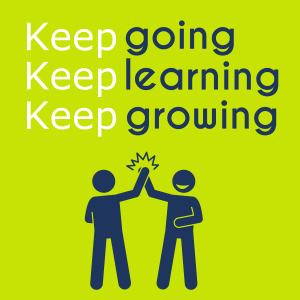
Focus Area 3: Communications
Summary
As we said at the start of this module, communication is the heartbeat of human interaction. It is too important to leave to chance when you're in human services work.
No doubt you’ve been aware of, and paying attention to, the need for effective communication for most of your life. Some of the learning in this module will certainly have been a review for you and there is always value in a refresher of the basics. Your experience and perspective both expand over time and revisiting the basics through your newly-expanded viewpoint can often reveal fresh insights and ideas to you.
It’s likely there was some new learning in here for you, too. For that, you’ll need to actually try on and practice implementing those concepts in your day-to-day interactions with young people and coworkers. When it comes to improving your ability to communicate effectively, knowing is way different than doing!
The biggest shift you can make to ensure you are a more effective, flexible communicator in any situation is to take ownership for ensuring the meaning of your message is properly perceived by the person you’re communicating with. Most of us have learned the opposite; that the listener is responsible for getting what we mean.
If you will embrace the idea that the meaning of your communication is the response it elicits, you’ll take greater care in how you communicate. And you’ll more naturally read and pick up on how your listener is reacting, as your measure of whether or not they got what you really meant. The more you practice non-verbals, attending skills, Collaborative Problem Solving (CPS) skills, and group interaction skills the more effective and flexible you will become in your work with young people.

Review the fundamental elements of effective communication:
- There are three elements of communication; Non-verbal, listening, and speaking
- Non-verbal communication typically conveys the highest percentage of the meaning of our communication, how our messages are received
Learn how to use various communication strategies and techniques for certain situations:
- You reviewed a number of techniques to use as a framework for achieving a desired outcome with youth. Given time and practice, these can become second nature to you and won’t feel so much like you’re using a “technique.”
- You got an overview from the Motivational Interviewing approach on how to employ O.A.R.S. as an active listening strategy
Improve your conflict resolution skills:
- You learned about six underlying concepts for successful problem-solving
- You learned that quality communication skills such as active listening and effective questioning are essential
- Difficult, positive, and crucial conversations are a daily part of youth work and you gained a framework for improving that communication
Learn the Collaborative Problem Solving (CPS) approach:
- The CPS model proposed three steps per Plan B; Identify the youth’s concerns about the issue or behavior challenge; Identify your concerns about the issue; Invite the youth to brainstorm solutions in collaboration with you
Gain group facilitation strategies and skills:
- Group norms help set the expectation for how each youth will participate and what the group objective is
- There are a number of situational strategies outlined for the typical circumstances that arise in working with groups. Having a strategy ahead of time will help you be more prepared and feel more confident in front of the group
Communications Quiz

Communicating effectively is both an art and a science. Having a good foundational understanding of the elements of effective communication, along with a willingness to practice and improve your communication skills throughout your life will most certainly make you a better youth worker. You’ve gotten the basis for that progress from this focus area module. It’s up to you to put them into practice.
Now you will demonstrate your learning by passing an 8-question quiz. If you’ve paid attention to the videos and carefully studied the content of the written material, you are well-prepared for the quiz. You need a score of at least 80% to pass. Good luck!

“Listen with curiosity. Speak with honesty. Act with integrity.― Roy Bennett, author of The Light in the Heart
You are awesome! As a youth worker, much of the impact you will make in a young person's life will be the result of your communication. Not so much the words you said but the way you listened, and heard, and respected them. Your caring communication will make a lasting impression in their heart for life. Want to expand your knowledge in this focus area? Click the link above and explore.
If you prefer to print this section of The Art & Science of Youth Work certificate course, click on the "Print Friendly" icon to select how you would like it to print. You can remove images and icons.
